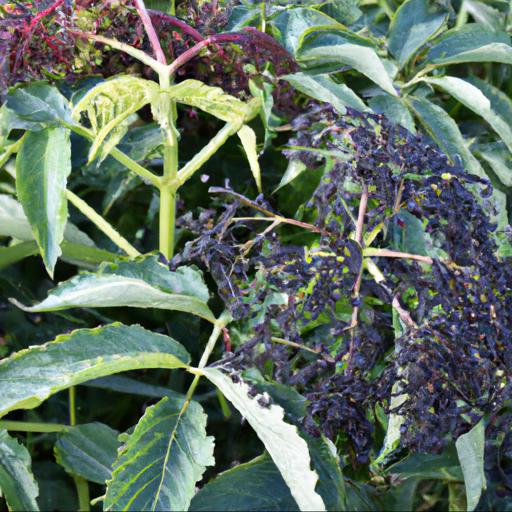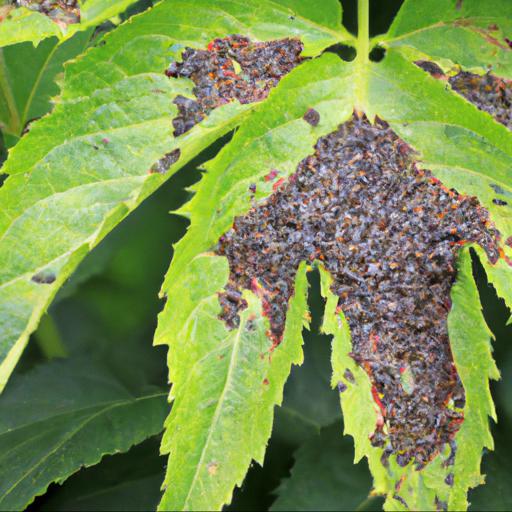Sambucus nigra black lace is a deciduous shrub that is native to Europe and western Asia. It is a member of the Adoxaceae family and is a popular ornamental plant due to its elegant and lacy foliage. This shrub can reach heights of up to 6 feet and is known for its fragrant clusters of creamy-white flowers that bloom in the summer.
The flowers are followed by dark purple-black berries that are edible and can be used to make jams and jellies. Sambucus nigra black lace is an easy to care for shrub and can be grown in a variety of climates and soil types.
Benefits of sambucus nigra black lace

The Sambucus nigra black lace is one of the loveliest landscaping additions you can make to your garden. This robust, deciduous shrub is known for its stunning, dark-purple foliage, panicles of small white flowers and ebony berries adorning every branch. Not only does its dramatic, dark color make it a unique eye-catcher, it also delivers a host of benefits that go far beyond its beauty.
Firstly, Sambucus nigra black lace provides unparalleled landscape appeal for your garden with its deep, sumptuous hue that appears to be black from a distance. This rich color carries through from new growth to pre-winter leaf fall, offering an eclectic contrast of tones throughout the year.
Its striking foliage is further highlighted by the plentiful white flowers it displays beginning in June and lasting until August. Each individual bloom manages to clump together, creating mass white flower clusters that add even bolder shades of contrast to its inky leaves.
The Sambucus nigra black lace stands out as an ideal choice for UK gardening in more ways than one; as it is remarkably unbothered by British climate and soil regulations. It requires minimal attention to thrive and is able to survive temperatures below zero and late frosts due to its thick, waxy leaf coating. It is even generally disease-resistant, leaving you with fewer worries about maintenance and upkeep.
In addition to its flawless aesthetic qualities, Sambucus nigra black lace also provides an array of benefits to the environment. Its dense foliage acts as a natural insulator for your garden and its flowers are incredibly attractive to pollinating insects. Its berries are also an essential source of nutrition for wild birds, offering them a feast of protein-rich snacks that help provide energy to keep them flying.
Overall, Sambucus nigra black lace is an unbelievably versatile and visually impressive addition to any garden. It yields a wealth of aesthetic and environmental benefits, as well as being resilient to British climate conditions.
By opting for this wise choice, you can add a luxurious and ornamental black lace feature to your garden that will boast endless benefits for years to come.
How to plant and care for sambucus nigra black lace

Planting and caring for the Sambucus nigra black lace is a task that gardeners across the UK can master. This hardy, deciduous shrub is well-worth the effort for its unique black foliage and fragrant, lacy pink flowers in the summer months. With a few pointers, even a novice gardener can achieve stunning results with this graceful plant.
When it comes to planting, the Sambucus nigra black lace loves full sun and moisture. Choose a spot in the garden that receives at least six hours of direct sunlight a day and incorporate plenty of well-rotted manure or compost into the soil.
With its deep black foliage and heart-shaped leaves, it is best suited to living in a woodland garden but can also be grown successfully in any sheltered sunny spot in the garden. Watering your Sambucus nigra black lace correctly is key to keeping it looking its best.
As it prefers moist soil, during the hot summer months aim for about an inch of moisture per week in the form of watering or rainfall. Make sure not to overwater, however, as this can encourage disease and root rot. Mulch around the base of the bush to help retain moisture, and keep an eye out for pests such as aphids.
Finally, in order to maintain its shape and size, trim your Sambucus nigra black lace annually by cutting off one third of the branches after it finishes flowering. Try to maintain the natural shape of the bush by removing only the new growth each year, leaving the mature branches in tact. With the right care and attention, your Sambucus nigra black lace will reward you with beautiful blooms and striking colour all summer long.
Common pests and diseases of sambucus nigra black lace

Sambucus nigra black lace is a strikingly beautiful plant that has become hugely popular in the UK garden market. With its bold dark foliage and lace-like pom-poms of fragrant white flowers, this stunning shrub has a lot to offer. While remarkably hardy and easy to grow, there are still some common pests and diseases that could affect your Sambucus nigra black lace.
The most frequent pests that impact Sambucus nigra black lace are those that feed on the foliage, such as aphids and spider mites. These can be easily identified by the stippled leaves they leave behind, which if left untreated can eventually lead to leaf discolouration and a decline in vigour.
To combat them, try spraying these pests with a strong jet of water or use a proprietary insecticidal soap. The most widespread issue when it comes to diseases of Sambucus nigra black lace are caused by fungi. The most common of these is powdery mildew, which leaves a powdery white-grey fungal growth on the foliage.
If left untreated, it can lead to reduced photosynthesis and weaker growth, so it’s best to address it quickly by spraying with a fungicide. Other fungal issues include leaf spot, rust and root rot.
Although common pests and diseases can affect Sambucus nigra black lace, they shouldn’t be a cause of alarm. With proper monitoring and quick corrective action, these issues can be easily managed and your Sambucus nigra black lace will be able to thrive and present its glorious feature all year round.
Creative uses for sambucus nigra black lace
When you hear the words “Sambucus nigra black lace,” your mind likely automatically envisions cascading flowers in rich burgundy that spill over garden walls and trims. However, this versatile deciduous shrub is capable of much more than providing an ornamental backdrop for your garden. As a UK garden expert, I’m here to walk you through some of the creative and unique applications for this humble plant.
For starters, Sambucus nigra black lace is a favorite of gardeners across Europe due to its ability to thrive in poor soils. This hardy shrub can tolerate drought and temperatures that would send other shrubs running for cover.
Its ornamental qualities have begun to be appreciated in North America as well, as nurseries have begun to carry it in recent years. Sambucus nigra black lace also makes an excellent privacy hedge, as its slim branches are vibrant enough to grow densely.
Its unique coloring help it grab attention in delicate urban gardens and courtyards, while its ease of pruning makes it ideal for tailored hedges and topiary-style designs. It also provides copious amounts of fragrance throughout the summer months, making it an inviting display in any setting. Finally, Sambucus nigra black lace also does well as an individual specimen in pots or along paths and entryways.
It can also make for striking centerpieces in garden beds and islands, again due to its uniqueness and eye-catching color. It looks especially impressive when interspersed between other types of shrubs and plants, as its foliage helps direct the eye and its signature arching branches give the impression of asymmetrical balance. In conclusion, Sambucus nigra black lace is a versatile and hardy shrub that can add visual interest to any UK garden.
Whether you choose to use it as part of a privacy hedge or focus on it as a specimen plant, you can be sure that this deciduous shrub will reward your efforts with its distinctive foliage and robust nature.
Our video recommendation
Conclusion
Sambucus nigra black lace is an ornamental shrub with lacy, dark purple foliage and fragrant, white flowers. It is a fast-growing, deciduous shrub that can reach up to 4m in height. It is a great choice for gardens and landscapes, as it provides a dramatic, showy contrast to other plants.
The shrub is also an excellent source of nectar for bees and other pollinators, making it an important part of the garden ecosystem.
FAQ
What are the benefits of Sambucus nigra Black Lace?
The benefits of Sambucus nigra Black Lace include its ability to boost the immune system, reduce inflammation, fight off infections, improve digestion, and reduce stress. It is also known to have antioxidant, anti-aging, and anti-cancer properties.
How does Sambucus nigra Black Lace grow?
Sambucus nigra Black Lace grows best in full sun to partial shade in moist, well-drained soil. It is a fast-growing shrub that can reach heights of up to 10 feet and spreads up to 8 feet. It is a deciduous shrub that produces fragrant white flowers in the spring and dark purple-black foliage in the summer.
What is the ideal climate for Sambucus nigra Black Lace?
The ideal climate for Sambucus nigra Black Lace is one that is cool and moist with full sun to partial shade.
How often should Sambucus nigra Black Lace be pruned?
Sambucus nigra Black Lace should be pruned annually in late winter or early spring.
What pests and diseases affect Sambucus nigra Black Lace?
Common pests and diseases affecting Sambucus nigra Black Lace include powdery mildew, aphids, spider mites, and leaf spot.
How can Sambucus nigra Black Lace be propagated?
Sambucus nigra Black Lace can be propagated by softwood cuttings taken in late spring or early summer, or by layering in late summer or early autumn.
